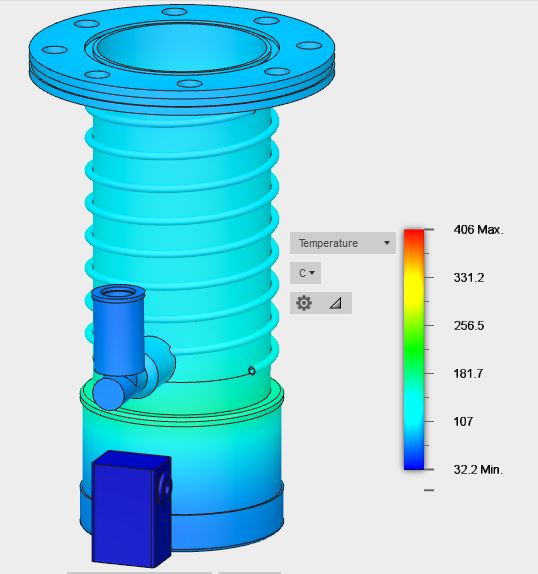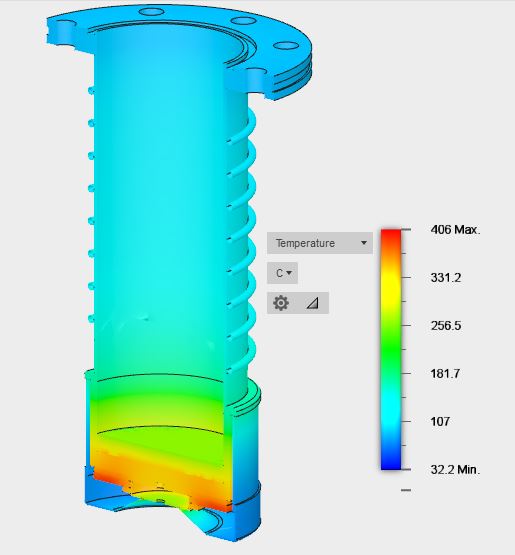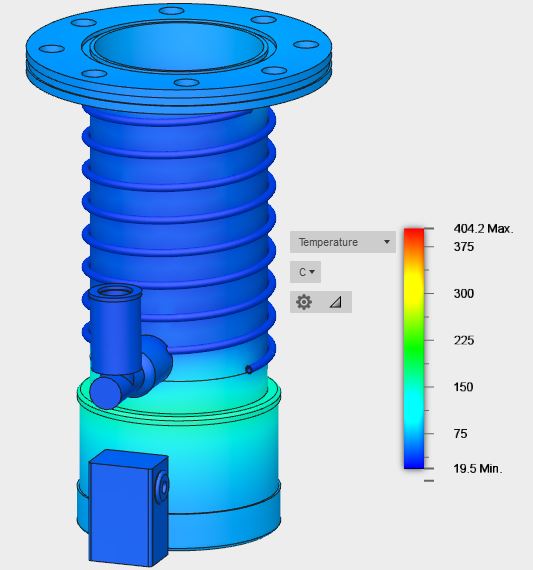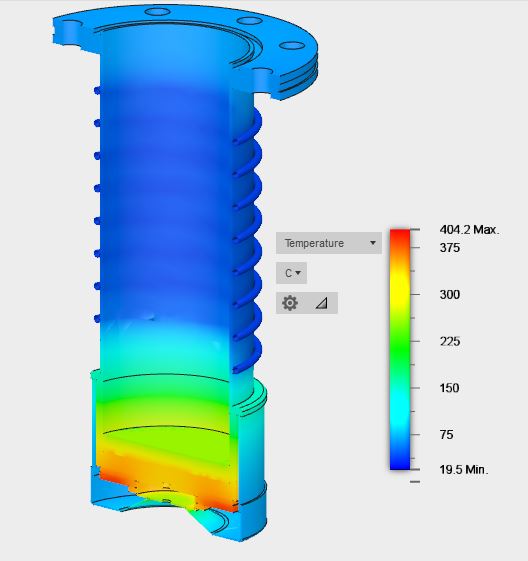UPDATE – As of 10/15/2018, the presented thermal analysis study is outdated and obsolete. A new, more accurate, and updated simulation model and analysis can be found HERE.
OVERVIEW
This thermal analysis study is a supplementary analysis for the full system design of the Small Scale Multipurpose High Vacuum System V4 Design. The goal and purpose of the study is to determine the steady state thermal characteristics of the major heat load of the vacuum system, which is the main high vacuum pump – an Edwards EO4 diffusion pump (850W). This study also serves as the precursor for a second study that covers the analysis of the liquid chilled optically dense baffle used in conjunction with the diffusion pump to eliminate backstreaming in the system during operation. Both studies are carried out to determine the estimated heat loads seen in the system that will have to be properly managed with the closed loop, multi-loop, chilled PID controlled cooling system for both the pump as well as the baffle.
The thermal modeling results are based off the CAD and thermal modeling analysis using Fusion 360. Although the diffusion pump is a dynamic system in reality, modeling the dynamic heat transfer of the internally sprayed vapor oil jets during operation would not be possible using free thermal analysis software, and more advanced software dealing with dynamic analysis and multiphysics systems is currently not available for this project with current budget restrictions. Due to budget restrictions, estimates needed to be made by employing a steady-state model looking at the static thermal conditions of the pump during operation. The results of this simplified model gives very acceptable and accurate data with a high degree of confidence for determining the basic thermal characteristics of the system needed for the next phase of the cooling system.
Thermal Study #1 – Uncooled EO4 Diffusion Pump
Summary:
The first thermal study aims to characterize the average maximum steady state temperature across the body of the diffusion pump in operation with no water cooling. This represents the worst case thermal load for the liquid cooling system that needs to be handled. The model omits the aluminum vapor stack internally in the pump for creating the vapor jets from evaporating oil for simplicity. The oil itself however is modeled by creating a custom material in Fusion 360 and inputting the necessary average material properties for DC-705 oil. The proper volume required during operating, 175mL, is also accounted for based on the given internal dimensions of the pump. Based on the below input parameters to the system, with an ambient temperature of 25C, an internal surface convection coefficient of 0.01 W/M^2 K to a temperature of 245C for convection in rough vacuum, a heater input power of 850W, and the applied convection and radiation loads for 304 stainless steel in atmosphere and vacuum, as well as DC-705 oil in rough vacuum conditions, the resulting temperatures are determined. Due to the fact that the thermal model is for a static system, not accounting for the full dynamics of the thermal transfer of the vapor spray, the resulting average temperature of the oil is expected to be higher than encountered at normal operation. However, since no external cooling is applied to the system other than radiation and convection coefficients for ambient air at 25C, the temperature of the oil should be elevated in reality if no cooling was applied, as shown in this model. In this case, the average temperature of the oil in the static model was found to be 291C, which is 46C higher than the operating temperature of 245C of DC-705, which represents an acceptable prediction based on static modeling alone. In addition, the average temperature across the main pump body between the inlet and outlet cooling lines was found to be 118.5C, which also represents a very reasonable expected temperature for the casing of the pump. Therefore, the cooling system must be able to dissipate at least 850W and manage a thermal gradient from the inlet temperature of 142C to the maximum recommended cooling temperature of 25C.
Initial Parameters:
- Ambient Temperature: 25C
- Internal Pump Temperature: 245C
- Pump Material: 304 Stainless Steel
- Thermal Conductivity of 304 Stainless Steel: 1.62E+01 W/m C
- Specific Heat of 304 Stainless Steel: 500 J/kg C
- Pump Oil: DC-705
- Thermal Conductivity of DC-705: 1.3 E-02 W/m C
- Specific Heat of DC-705: 1758 J/kg C
- Oil Fill Volume: 175 mL
Thermal Loads:
- Applied Internal Heating Load to Resistive Heater Disk: 850W
- Convective Load of Body and Casing to Ambient Air: 5 W/m^2 K
- Convective Load Of Internal Surface to Atmosphere in Vacuum (1 x 10^-2 Torr): 0.01 W/m^2 K
- Radiation Emissivity Coefficient of 304 Stainless Steel: 0.65
- Convective Load of DC-705 Oil (Heavy Oil Steam in a Vacuum): 141.957 W/m^2 K
- Radiation Load of DC-705 Oil (Thick Oil Film on Metal): 0.80
Resulting Temperatures:
- Min System Temperature: 32.2C
- Max System Temperature: 406C
- Temperature of Casing at Water Inlet: 96C
- Temperature of Casing at Water Outlet: 142C
- Average Casing Temperature: 118.5C
- Average Temperature of Oil: 291C
Thermal Study #2 – Water Cooled EO4 Diffusion Pump
Summary:
The second thermal study aims to characterize the average maximum steady state temperature across the body of the diffusion pump in operation with an applied constant water cooling temperature. The selected temperature for the water cooling in the model is 25C, which represents the maximum recommended cooling temperature for the diffusion pump during operation. This model represents the thermal load and resulting temperatures of the system that will actually be encountered during normal operation of the pump with an appropriate cooling system. The model inputs are identical to Study #1, with the additional thermal load of a constant 25C temperature on the internal surface of the cooling lines, which represents the cooling water. Based on the below input parameters to the system, with an ambient temperature of 25C, a heater input power of 850W, an internal surface convection coefficient of 0.01 W/M^2 K to a temperature of 245C for convection in rough vacuum, as well as appropriate convection and radiation coefficients DC-705 oil in rough vacuum conditions, the resulting temperatures are determined. Due to the fact that the thermal model is for a static system, not accounting for the full dynamics of the thermal transfer of the vapor spray, the resulting average temperature of the oil is expected to be higher than encountered at normal operation. Therefore, the oil temperature is affected only by radiation and convective values applied to the model, resulting in a higher average temperature than in reality. In this case, the average temperature of the static model of the DC-705 oil fill was still found to be 291C, which is 46C higher than the operating temperature of 245C of DC-705, which can be now further explained based on the following for this model. Based on the geometry on the pump, the thermal mass of the whole system is not enough to cool the oil from the temperatures predicted in Study #1, and thus necessitates the need for cooling transfer from condensed vapors on the cooled pump walls when water flow is applied. In addition, the average temperature across the main pump body between the inlet and outlet cooling lines was found to be 50C, with the constant applied cooling temperature of 25C. This casing temperature of 50C nearly matches the 46C temperature differential between the predicted oil temperature and the expected oil temperature during operation, which would reasonably explain the cooling required for the oil at its expected operating temperature of 245C when the vapors are dynamically spraying onto the 50C cooled walls, and falling back to the main oil reservoir, further verifying the accuracy of this simplified steady-state static model study within reasonable confidence and operational expectations.
Initial Parameters:
- Ambient Temperature: 25C
- Internal Pump Temperature: 245C
- Constant Water Cooling Temperature: 25C
- Pump Material: 304 Stainless Steel
- Thermal Conductivity of 304 Stainless Steel: 1.62E+01 W/m C
- Specific Heat of 304 Stainless Steel: 500 J/kg C
- Pump Oil: DC-705
- Thermal Conductivity of DC-705: 1.3 E-02 W/m C
- Specific Heat of DC-705: 1758 J/kg C
- Oil Fill Volume: 175 mL
Thermal Loads:
- Applied Internal Heating Load to Resistive Heater Disk: 850W
- Convective Load of Body and Casing to Ambient Air: 5 W/m^2 K
- Convective Load Of Internal Surface to Atmosphere in Vacuum (1 x 10^-2 Torr): 0.01 W/m^2 K
- Radiation Emissivity Coefficient of 304 Stainless Steel: 0.65
- Convective Load of DC-705 Oil (Heavy Oil Steam in a Vacuum): 141.957 W/m^2 K
- Radiation Load of DC-705 Oil (Thick Oil Film on Metal): 0.80
Resulting Temperatures:
- Min System Temperature: 25C
- Max System Temperature: 404.5C
- Temperature of Casing at Water Inlet: 40C
- Temperature of Casing at Water Outlet: 60C
- Average Casing Temperature: 50C
- Average Temperature of Oil: 291C




